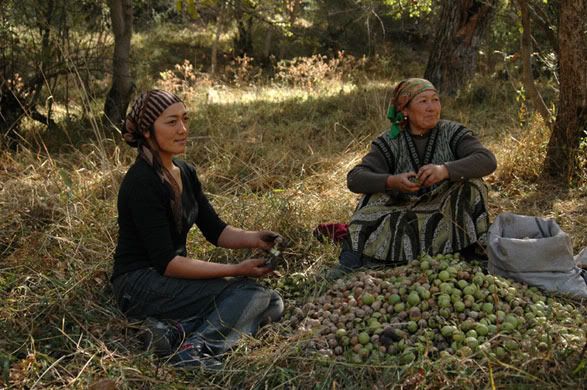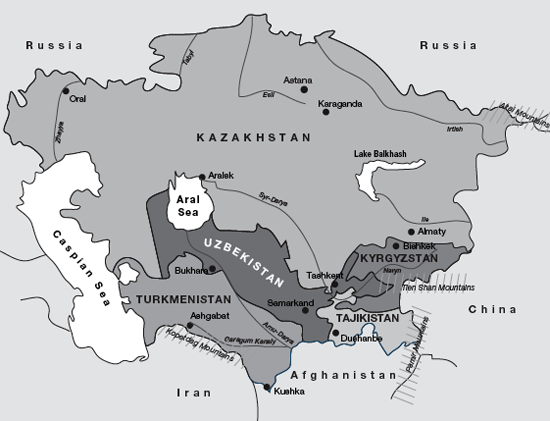( – promoted by buhdydharma )
 During last year’s U.S. presidential campaign, Barack Obama campaigned on a pro-pie platform. But apple pie, an epitome of Americanness, is threatened by the apple’s stagnant gene pool.
During last year’s U.S. presidential campaign, Barack Obama campaigned on a pro-pie platform. But apple pie, an epitome of Americanness, is threatened by the apple’s stagnant gene pool.
Like many Americans, the apple is an immigrant to the United States. The apple’s ancestors came from Central Asia. Today, wild apple trees grow in the Tien Shan Mountains in Western China and in neighboring Kazakhstan. Almaty, the former capital, of Kazakhstan literally means ‘the Father of Apples’.
In addition to wild apple, Central Asia is home to more than 300 wild fruit and nut species, including plum, cherry, apricot, pistachio, walnut and many other important food trees from which domesticated varieties are thought to originate.
A team of international scientists have completed an inventory of Central Asia’s trees and identified 44 species in Kazakhstan, Kyrgyzstan, Uzbekistan, Turkmenistan, and Tajikistan as globally threatened with extinction.

A bowl of local fruit and nuts in Kyrgyzstan |
The Red List of Trees of Central Asia (pdf) lists two ancestors of today’s domesticated apples as endangered. “Two wild apple species, Malus niedzwetzkyana and Malus sieversii, are still found in the fragmented fruit and nut forests of Central Asia and are threatened by habitat degradation, mainly from agricultural development and overgrazing.”
Most apples grown today in the United States come from the same five or six parents. As Michael Pollan explained in a 1998 article in the New York Times:
That genetic uniformity makes the apple a sitting duck for its enemies. In the wild, a plant and its pests are continuously coevolving, in a dance of resistance and conquest that can have no ultimate victor. But coevolution freezes in an orchard of grafted trees, since they are genetically identical. The problem is that the apples no longer get to have sex, which is nature’s way of testing out fresh genetic combinations. The viruses, bacteria and fungi keep at it, however, continuing to evolve until they’ve overcome whatever resistance the apples may have once possessed.
Over the past century, the genetic diversity of America’s apple varieties have dropped from several thousands to a handful. With apples genetically locked in, pests have an evolutionary advantage of wiping out America’s apple crops. “Anyone with an apple in his yard knows how pathetic these trees can be… No other crop requires quite as much pesticide as commercial apples, which receive upward of a dozen chemical showers a season,” Pollan observed.
“The solution,” according to Philip Forsline, a USDA horticulturist at the New York State Agricultural Experiment Station, “is for us to help the apple evolve artificially” and mingle in fresh genes to our domestic apple varieties through breeding. Keeping as many wild apple genes available is therefore vital for the domesticated apple’s survival. Pollan wrote:
“It’s a question of biodiversity,” Mr. Forsline said, as we walked down rows of antique trees, tasting apples as we talked. Every time an old apple variety drops out of cultivation, or a wild apple forest succumbs to development (as is happening today in Kazakhstan), a set of genes vanishes from the earth…
The greatest biodiversity of any crop is apt to be found in the place where it first evolved, where nature first experimented with what an apple, or potato or peach, could be.
Only eight years later, ScienceDaily reported Forsline and plant geneticist Gennaro Fazio experiments breeding wild apples with domestic varieties found them to me more resistant to diseases and fungi. A finding that they “documented with astonishment”. Fazio and Forsline were “most impressed with the material collected in Kazakhstan, especially accessions of Malus sieversii“.
According to Forsline, the Kazak trees showed significant resistance to apple scab–the most important fungal disease of apples-as well as to fire blight. They were highly resistant against Phytophthora cactorum, which causes collar rot, and Rhizoctonia solani, an agent of apple replant disease, according to Fazio. Both researchers found genes in the Kazak apples that allow them to adapt to mountainous, near-desert, and cold and dry regions.
As the Red List study, which was published by the Fauna & Flora International (FFI), explains:
The genetic diversity of fruit and nut trees within the region is of outstanding global significance. As elsewhere in the world, the trees of Central Asia face an onslaught of threats from habitat destruction, over-grazing, over-harvesting and the increasing impact of global climate change…
The mountains of Central Asia are a recognized global biodiversity hotspot, supporting over 300 wild fruit and nut species. These include wild species of apple (four species), almond (8-10 species), cherry (8-10 species), plum (4-5 species), and walnut (one species) as well as many domesticated varieties.
So not only are the ancestors of our apples from Central Asia, but also other genetically important species of fruit and nut trees come from the region. Protecting these trees’ natural habitat and cultivating them may prove vital to keeping the world’s food supply resilient into the future within a changing climate.
Ninety percent of the forest habitat for these fruit and nut trees has been lost in the past 50 years according a Conservation International estimate. In addition, as the study notes, “the region has undergone dramatic economic, social and political transition following independence from the former Soviet Union in 1991” which has put tremendous stress on Central Asia’s forests and woodlands to prove fuel, food, and income.
“Although logging is officially illegal in the majority of the indigenous forests in Central Asia, substantial quantities are still removed”, according to the study. 80 percent of the rural Tajikistan household rely on wood fuel for cooking.
Additionally, “walnuts, apples, and pistachios are an important source of livelihoods for rural communities in Central Asia.” Collection “ranges from subsistence harvesting to collection for international trade” which “can be a major source of income for the local population, especially during years of good harvest”.

People in Kyrgyzstan gather the annual walnut harvest |
The trees in one Central Asian country were not inventoried in the Red List study. With the ongoing war in Afghanistan, the trees in its forests went unexamined. Afghanistan was once “known as the orchard of Central Asia” as then-Senator Hillary Clinton said in 2005. A stable Afghanistan may be vital to the survival of Central Asia’s vulnerable trees.
The United Nations’ Food and Agricultural Organization wrote in 2002:
In happier days, Afghanistan was a paradise of orchards and vineyards, spice gardens and forests. Sophisticated irrigation systems watered crops and were channeled into beautiful pleasure gardens for the leisure classes. In the 1960s, high-value horticulture and dried fruit provided Afghanistan with almost half of its export revenue…
In most of Afghanistan today, the gardens have been decimated by drought. All that remains of the extensive pistachio forests of Badakhshan province, for example, are a few trees standing stark against the mountains. “We have destroyed an economic resource,” says the provincial Acting Governor, Muhammed Shah Zijhum. “And bare mountains mean more floods and soil erosion.”
If the remaining forests of Central Asia are allowed to fail, then I think it is possible that more wars will break out and spread in the region. As the Red List study illustrates, the forests of Central Asia are shrinking due to the demands placed on them and these pressures, combined with a lack of forest management, is making it a possibility, as BBC News emphases, that these wild fruit trees face extinction. The fruit and nut trees are “disease-resistant and climate-tolerant” and “could play a role in our future food security.”
Antonia Eastwood, the lead author of the research, described the region as a “unique global hotspot of diversity”.
“A lot of these species are only found in this area… It’s very mountainous and dry, so many of these species have a great deal of tolerance to cold and drought.
“A lot of our domestic fruit supply comes from a very narrow genetic base,” she continued. “Given the threats posed to food supplies by disease and the changing climate, we may need to go back to these species and include them in breeding programmes.”
Apples are not uniquely vulnerable. Many of the grains, roots, fruits, and vegetables that we eat today are susceptible to disease and pests.
The world’s wheat crop, for example, is threatened by a virulent new strain of stem rust fungus spreading out of Kenya. The banana that is widely available today is not the tastier Gros Michel variety, which was wiped out by disease by the 1960s, but the blander, inferior Cavendish banana. And, climate change in the Andes Mountains is allowing potato blight, the same mold that contributed to the Great Famine in Ireland, to cause problems for farmers in Peru.
There are “a number of limitations” in relying on seed banks, according to a 2006 study by WWF International, Food Store: Using protected areas to secure crop genetic diversity (pdf), so interest in “the conservation of ecosystems and natural habitats and the maintenance and recovery of
viable populations of species in their natural surroundings” has been growing steadily since the 1990s. Compared to maintaining seed banks, it is more cost effective to preserve ecosystems.

Kyrgyzstan |
Additionally, seed banks have the same problem of locking the plant’s genes in place, just like we’ve done with our domestic apples. Storing seeds “freezes adaptive evolutionary development, especially that which is related to pest and disease resistance”. Allowing for plant species to live in their natural environments “allows for natural genetic interactions between crops, their wild relatives and the local environment to take place”.
The danger with relying solely on conservation, however, is “under extreme conditions of environmental change (such as catastrophes, or rapid climate change) catastrophic loss of genetic diversity rather than adaptation is likely to occur”. So, a mixed approach is important. Keeping the wild varieties in seed banks and in research stations, and preserving these plants natural environments. Because, the genes contained in these wild varieties may prove essential to the survival of not only our domestic varieties of apple, but many other fruit and nut varieties.
A financial commitment in preserving and protecting can make a difference according to the Red List study. “Many of the state agencies lack basic equipment and infrastructure such as uniforms, horses or vehicles, communication equipment and ranger posts. In order to alleviate the immediate pressures on forests from firewood collection and illegal logging, pilot projects that provide alternative sources of energy to villagers should be trialled, assessed and rolled out.”
It is a sad irony that the progenitor of the domesticated apple, Malus sieversii, is threatened by extinction in its natural environment, whilst the export value of apples from the top ten apple producing countries is over US$3 billion a year.
More poignantly, Malus sieversii germplasm collected in the 1990s from Kazakhstan is currently being used by the USDA Agricultural Research Service to improve disease resistance in current apple cultivars. So far, researchers have discovered Malus sieversii samples that show resistance to apple scab, fire blight, drought and numerous soil pathogens. These research findings once again highlight the global importance of conserving the wild relatives of domesticated fruit and nut trees.
The good news is that it isn’t too late that we can make a difference. The Independent reports:
FFI is already working in Kyrgyzstan to save and restore one of the most highly threatened apple species identified in the report, the Niedzwetzky apple (Malus niedzwetzkyana), as part of its Global Trees Campaign. Only 111 individuals of this tree are known to survive in Kyrgyzstan and the species features on the Red List as “endangered” – the second highest category of threat.”
FFI is also working with local communities and government forest services in Kyrgyzstan and Tajikistan to encourage sustainable use and more effective protection for forest resources, including providing training for community groups and grants for eco-friendly small businesses to assist local livelihoods.
 But, I think NGOs such as FFI cannot do this alone. The United States, the European Union, and other nations have an interest in not only the stability and security of their country’s and the world’s food supply, but also with the potential spread of Taliban-inspired radical Islam in Central Asia.
But, I think NGOs such as FFI cannot do this alone. The United States, the European Union, and other nations have an interest in not only the stability and security of their country’s and the world’s food supply, but also with the potential spread of Taliban-inspired radical Islam in Central Asia.
So, perhaps in addition to the military payments and the USAID programs, the U.S. is funding in Kyrgyzstan, Kazakhstan, Uzbekistan, Turkmenistan, and Tajikistan in 2009 that focus on each country’s economic sector, healthcare system, and democratic institutions, I think we should also invest in helping them protecting their threatened forests and other ecosystems. Not only would we be helping the people of Central Asia, but we’d also be helping ourselves.
After all, I think it would be a terrible loss if we let a shrinking gene pool take away something as American as apple pie.
Cross-posted at Daily Kos.


5 comments
Skip to comment form
Author
I had no knowledge about it prior to this and now you have added to my massive (and growing) must read up on list!
I love that about this place!